Apr 20, 2011
Why it seems like severe weather is more common when the data shows otherwise
By Anthony Watts, in the Daily Caller
On his blog, Dr. Roger Pielke Jr. writes:
A new analysis of floods around the world has been called to my attention. The new analysis is contrary to conventional wisdom but consistent with the scientific literature on global trends in peak streamflows. Is it possible that floods are not increasing or even in decline while most people have come to believe the opposite?
Bouziotas et al. presented a paper at the EGU a few weeks ago (PDF) and concluded:
“Analysis of trends and of aggregated time series on climatic (30-year) scale does not indicate consistent trends worldwide. Despite common perception, in general, the detected trends are more negative (less intense floods in most recent years) than positive. Similarly, Svensson et al. (2005) and Di Baldassarre et al. (2010) did not find systematical change neither in flood increasing or decreasing numbers nor change in flood magnitudes in their analysis.”
Note the phrase “despite common perception.” I was very pleased to see that in context with a conclusion from real data.
That “common perception” is central to the theme of “global climate disruption,” started by John P. Holdren in this presentation, which is one of the new buzzword phrases being used in the place of “global warming” and “climate change” to convey alarm.
Like Holdren, many people who ascribe to doomsday scenarios related to AGW seem to think that severe weather is happening more frequently. From a perception not steeped in the history of television technology, web technology, and mass media, which has been my domain of avocation and business, I can see how some people might think this. I’ve touched on this subject before, but it bears repeating again.
In recent years, the reach of communications technology has expanded and the speed with which natural disasters are reported has increased. With global news coverage, instant messaging, and Internet-enabled phones with cameras, is it any wonder that nothing related to severe weather or disaster escapes our notice anymore? This improved reporting makes it seem as if severe weather events and disasters are becoming much more frequent.
Using this Wikipedia timeline as a start, I created a timeline that tracks the earliest communications to the present, adding severe weather events of note and weather and news technology improvements for context. Here’s an excerpt of it (to see the full timeline, click here).
1450 - Johannes Gutenberg finishes a printing press with metal movable type.
1812 - The Aug. 19, 1812 New Orleans hurricane that didn’t appear in Washington, D.C.’s Daily National Intelligencer until September 22.
1876 - Alexander Graham Bell and Thomas A. Watson exhibit an electric telephone in Boston.
1914 - Teletype introduced as a news tool. The Associated Press introduced the “telegraph typewriter” into newsrooms in 1914, making transmission of entire ready-to-read news stories available worldwide.
1946 - The DuMont Television Network, which had begun experimental broadcasts before the war, launched what Newsweek called “the country’s first permanent commercial television network” on August 15, 1946.
1963 - First geosynchronous communications satellite is launched.
1982 - The Weather Channel (TWC) is launched by John Coleman and Joe D’Aleo with 24-hour broadcasts of computerized weather forecasts and weather-related news.
1992 - Hurricane Andrew, spotted at sea with weather satellites, is given nearly continuous coverage on CNN and other network news outlets as it approaches Florida. Live TV news via satellite coverage as well as some Internet coverage is offered. It was the first Category 5 hurricane imaged on NEXRAD.
2011 - Notice of an earthquake off the coast of Japan was blogged near real-time thanks to a USGS email message alert before TV news media picked up the story, followed by a tsunami warning. A Japanese TV news helicopter with live feed was dispatched and showed the tsunami live as it approached the coast of Japan and hit the beaches. Carried by every major global news outlet and live-streamed on the Internet, it was the first time a tsunami of this magnitude was seen live on global television before it impacted land.
To borrow and modify a famous phrase from James Carville: It’s the technology, stupid.
Here’s the truth:
1. There have been relatively few tornadoes in the USA in recent years:
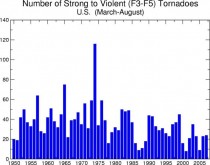
Source: National Climatic Data Center (enlarged)
2. Global tropical cyclone activity, as measured by frequency and ACE, is at the lowest level in 30 years, despite 2010 being claimed as the warmest year ever:
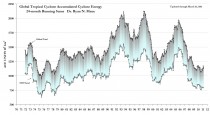
Global Tropical Cyclone ACE (Dr. Ryan N. Maue, FSU) (enlarged)
3. And there is no evidence that the frequency of flooding has increased in recent years:
Destructive floods observed in the last decade all over the world have led to record high material damage. The conventional belief is that the increasing cost of floods is associated with increasing human development on flood plains (Pielke & Downton, 2000). However, the question remains as to whether or not the frequency and/or magnitude of flooding is also increasing and, if so, whether it is in response to climate variability and change.
Several scenarios of future climate indicate a likelihood of increased intense precipitation and flood hazard. However, observations to date provide no conclusive and general proof as to how climate change affects flood behavior.
Finally, this parting note: While our world has seen the explosion of TV news networks, Internet news websites, personal cameras and recording technology, smartphones with cameras, and the ability to submit a photo or movie or live video feed virtually anywhere, anytime, giving us instant reporting of disasters, there’s one set of elusive phenomena that still hasnít seen an increase in credible reporting and documentation: UFOs, the Loch Ness Monster, and Bigfoot.
We still haven’t seen anything credible from the millions of extra electronic eyes and ears out there, and people still marvel over old, grainy images. You’d think that if they were on the increase, we’d know about it.
--------------
Editorial: Don’t Look Now, But C02 Output Is Falling
IBD Editorial
Environment: Two years ago, greenhouse gas emissions in the U.S. fell to their lowest levels since 1995. The list of reasons carbon dioxide emissions should not be regulated continues to grow.
The Environmental Protection Agency’s data show that emissions of what are considered the six main greenhouses gases fell 6.1% in 2009 from their 2008 levels.
Yes, levels increased by 7.3% from 1990 to 2009. But the average annual rate of increase since 1990 has been a mere 0.4%, a data point that doesn’t seem worthy of the high-intensity hysteria that’s been spread by the alarmists.
In the same year greenhouse emissions fell, the EPA, which should be an acronym for Eternally Panicked and Alarmed, determined “that climate change caused by emissions of greenhouse gases threatens the public’s health and the environment.” Regarding politics to be more important than science, it has taken it upon itself to regulate carbon dioxide as a “pollutant.”
“Climate change is happening now,” the EPA has claimed, “and humans are contributing to it.”
This is the same EPA, it was revealed in congressional testimony last week, that ignores the negative impact its regulations have on jobs, even though an executive order requires EPA rule makers to protect job creation. And it’s the same EPA that plans to regulate CO2 without congressional approval.
If the agency is so keen on regulating carbon dioxide, maybe it should turn its attention to China, which has surpassed the U.S. in CO2 emissions. While U.S. greenhouse gas emissions increased 7.3% from 1990 to 2009, China’s carbon dioxide emissions have soared roughly 175% since 1999. If CO2 emissions must be cut, then China is where the cutting has to start.
If not, it doesn’t matter what the U.S. does. For every part per million of carbon dioxide that Americans cut, China, and its ever-burgeoning population and growing economy, will be pumping out even more.
Fortunately, there’s no reason for any nation to cut its carbon dioxide emissions. CO2 is not a pollutant in the usual sense. It is, in the words of John R. Christy, a professor of atmospheric sciences at the University of Alabama, “a plant food.”
“The green world we see around us would disappear if not for atmospheric CO2,” Christy says.
“These plants largely evolved at a time when the atmospheric CO2 concentration was many times what it is today,” he adds. “Indeed, numerous studies indicate the present biosphere is being invigorated by the human-induced rise of CO2.”
It is because of its presence in everything from breathing to driving to manufacturing to reading at home under the lights that CO2 makes a strong leverage point for those who want bureaucratic control over the rest of us, says Richard S. Lindzen, a professor of atmospheric science at the Massachusetts Institute of Technology.
And if CO2 continues to fall, or remains nearly flat, what will the alarmists do? Will environmentalists find a new bogeyman? They will. But they better hurry. The time they have left to demonize CO2 is running short.
Apr 18, 2011
Warming not extreme
Chiefio
This is an interesting article. The gist of it is that ‘recent’ warming in the 20th century was not out of range of normal as compared to other times. Has a couple of nice graphs, too:
The claim is often made that the rate of temperature change the Earth has experienced over the last 40 years is ‘unprecedented’, and is therefore likely to be man-made.
A quick look at the Vostok[1], EPICA[2] and GISP2[3] ice core records do not appear to support this claim, even within the stable part of the Holocene:
At that point there are some nice graphs showing trendless jiggly wigglies. Well worth hitting the link to take a look.
Then in a comment:
Juraj V. says:
This is the rate of warming/cooling calculated between the individual decades from the CET record.
“Can someone explain what data does support this claim?”
Alas, only these ones:
I’ve taken the liberty of linking to that first image here:
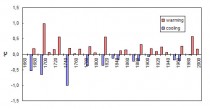
Temperatures CET by Decades
All in all it’s pretty clear that the only thing “unprecidented” about the rate of temperature changes is the hype being shoveled about it.
Apr 16, 2011
Spring storm brings Blizzard and 225 tornado reports
Blizzard shuts I-80 in Nebraska, strands motorists
Fri, Apr 15 2011
OMAHA, Nebraska (Reuters) - A spring blizzard dumped up to 16 inches of snow in Nebraska, stranding dozens of motorists and forcing the closure of state’s main highway, Interstate 80, for a 120 mile stretch, officials said on Friday.
Nebraska officials urged motorists to stay put on I-80, which was closed Thursday night and remained shut down Friday afternoon to allow authorities to clear stranded vehicles, mainly from a 12-mile construction zone.
The construction zone between Paxton and Ogallala, Nebraska, had many stranded semi-trailer trucks. A handful of accidents were reported, but no serious injuries, Nebraska State Patrol spokeswoman Deb Collins said.
It will still be slow driving conditions in the area once the roads are reopened, Collins said.
“We have traffic backing up at interstate closure points both east and west and basically they have nowhere to go,” Troop D Commander Captain Jim Parish said.
Falling tree limbs weighted with heavy, wet snow pulled down power lines and snapped power poles in the region where the states of Nebraska, Kansas and Colorado meet.
The storm started as rain in some areas and developed to snow overnight with surface winds increasing to blizzard conditions across southwest Nebraska by Thursday evening, the National Weather Service said.
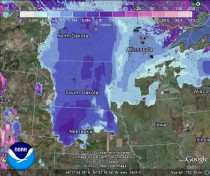
Enlarged.
Paxton, Nebraska, was hit by 16 inches of snow and drifts in west central Nebraska reached 5 feet deep, the weather service said.
225 reported Tornadoes through the south and east Thursday through Saturday

Enlarged.
The storm, typical of strong La Ninas in the cold PDO brought 225 reports of tornadoes through early this morning (Sunday). The last few days Oklahoma and the south were under the gun (see this animation of the storms in Oklahoma thanks to Ryan Maue).
Here is the SPC preliminary storm tracking for the 14th.
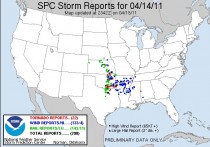
Enlarged.
Here on the 15th we see the storms further east.
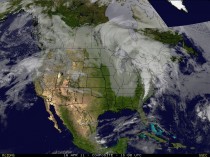
Enlarged.
Here is the preliminary SPC storm tracking for the 15th
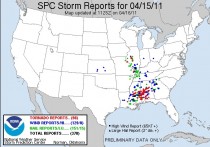
Enlarged.
And here is Saturday, the 16th with 105 more tornado reports to bring the 3 day preliminary total of tornado reports to 225!
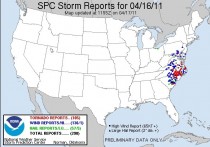
Enlarged.
See more reasons why on WeatherBell and see in the first post in mid March why we thought this would be a very active tornado season, subject to major outbreaks. See Joe Bastardi’s video on why there are more tornadoes this year.
Apr 15, 2011
A rational choice of energy sources
The Scientific Alliance Newsletter
Despite the intense debates which occur about the merits of different sources of electricity, the fact is that governments have an obligation to keep the lights on for their citizens. Modern societies need a constant supply of energy so that businesses can operate efficiently and individuals can be safe and comfortable. Even short power cuts can be very disruptive: computers stop working, broadband connections are lost, modern phones will not work, central heating pumps and boilers cut out and candles and torches are the only sources of light. Imagine if this was a regular occurrence.
This power, of course, does not always have to be generated in the same way. Many countries have moved from an almost total reliance on coal towards greater use of gas. Nuclear is part of the mix for many and France has chosen to make it its primary source of energy. For countries with the right geography, such as Norway, hydroelectricity is the obvious answer and in a few cases (eg Iceland) geothermal power is viable. But in all cases, a mix has been arrived at which can - barring occasional problems - provide energy security at a reasonable price.
This could change over the next few years. The current drive to reduce the carbon intensity of power generation ahead of whatever changes free market forces might bring risks placing undue reliance on intermittent sources of power, particularly wind generation, which is the most mature and generally the least expensive of the non-nuclear alternative options. Even enthusiasts agree that the intrinsically intermittent nature of the wind means that turbines on average only generate a fraction of their nominal capacity. What is still a very controversial issue is the extent to which this can be accommodated within an overall generating mix.
The John Muir Trust, which describes itself as the ‘leading wild land conservation charity in the UK’ has therefore done a valuable service by commissioning a report on the topic from Stuart Young, called (accurately but somewhat prosaically) Analysis of UK Wind Power Generation; November 2008 to December 2010. Using publicly-available information, this analyses the data to give a rather less positive assessment than we get from organisations such as Renewable UK (until recently the British Wind Energy Association, but now also covering wave and tidal power) or the Renewable Energy Association. It will not have pleased Alex Salmond, First Minister of Scotland, who spoke at a recent conference of ‘putting Scotland at the forefront of the global energy revolution’.
Critics may say that the John Muir Trust has an axe to grind, because it does not want to see wind turbines erected in what is currently wilderness. This is a fair point, but very few reports are published for purely altruistic reasons and it is for the reader to judge for themselves the objectivity of the author. In the case of the JMT report, the facts are allowed to speak for themselves. The National Grid, via its Balancing Mechanism Reporting System, provides very detailed data, publishing information every five minutes since November 2008. This data can be accessed by anyone, including those who may be sceptical of Stuart Young’s conclusions.
The author set out to test a series of statements often made in support of wind power and, in so doing, came to some important conclusions about its ability to make a useful contribution to the mix. For example, based on these data, he concludes that a figure of 30% of rated capacity for the average outputs of on-shore wind farms is a significant over-estimate. For November and December 2008, the figure was 31.7%, but in 2009 it fell to 27.2% and in 2010 was only 21.1%. Over the whole period covered, the average was just 24.1%. It should be said that the NG figures include only metered wind farms, but these are all in Scotland, which we can safely assume to be windier than the UK average. Including on-shore wind turbines in England would only make the picture worse.
This is one aspect; in terms of planning investment, it would be safe to assume that on-shore wind farms would have an average output of only about a quarter of their rated capacity. But even more important is the variability of the output. It has already been argued many times that wind farms can do little to reduce carbon dioxide emissions because conventional generating capacity has to be kept running inefficiently on standby to make up the shortfall when the wind is too weak (or too strong). The ability of the grid to cope with large, rapid changes in supply has also been questioned.
The analysis in the report gives a good illustration of this. To summarise, the metered wind farms operate:
At below 20% of capacity more than half the time
Below 10% of capacity more than one-third of the time
The equivalent of one day in twelve below 2.5% capacity
The equivalent of just under one day a month below 1.25% capacity
To compound this, the total output from the wind farms (about 1600MW metered capacity) was less than 20MW on average more than once a week, and this low output typically lasted for nearly five hours on each occasion. To compound this “Movements in excess of 100MW over a five minute period are relatively common even at the low levels of metered capacity during the study period. As more wind power is connected the magnitude of rapid changes will increase.”
Some people will see this report and its conclusions as an attack on wind power. I prefer to see it as a recognition of the reality and an aid to rational decision making. If the objective is to reduce the carbon intensity of electricity generation, it makes no sense to wilfully ignore the negative aspects of particular technologies. To do so would be to saddle the country with a power grid which is not fit for purpose.
Even enthusiasts for renewables should take proper note of these issues. Professor David MacKay, Cambridge academic and currently Chief Scientific Adviser at the UK Department of Energy and Climate Change is both a committed environmentalist and an excellent and rational scientist. For those who want to look at the broader issues of energy generation and use in more detail, the first point of call should be his extremely useful (and free in pdf form) book Sustainable energy - without the hot air. Rather than make the sort of unwarranted assumptions some are prone to do, he estimates capacities and outputs from first principles. Both he and Stuart Young have made invaluable contributions to the debate and we can only hope that they are the voices which are listened to.
Apr 14, 2011
Greens target women to save their failing cause with the ‘toxic’ lie
Environmental groups battling to protect U.S. EPA’s power over climate rules today launched a strategy with a new ally: women.
The Sierra Club and League of Women Voters plan to hold a series of phone briefings targeting 500,000 women in seven states, talking to them about what the green groups see as the risks to health if EPA loses its authority over air rules. Dubbed the “Talking About Toxics Program,” it is an effort to reframe the debate.
The organizations, which already had shifted to focusing on health versus climate, will be talking about “health and families,” according to a strategy document obtained by Greenwire.
“The environmental and health communities need to do more to build on our success at framing the fight to limit dangerous industrial pollution around public health,” the document says. “If Congress refuses to believe the research, we should put our strongest voices forward to tell the story about the vast harm toxic air pollutants, including particulate matter, ozone, mercury, formaldehyde, arsenic, lead and carbon can do to families.
“We need to reach out to more women and mobilize those women to weigh in on both the administrative and legislative fights,” it adds.
The first “tele-town hall” is scheduled for this evening in Ohio. Others tentatively are planned for Michigan, Pennsylvania, Minnesota, Missouri, Colorado and Massachusetts. Those are considered states with key lawmakers in the brawls over EPA’s power.
The calls come as Congress continues to target the agency and as supporters and opponents submit comments on EPA’s proposed toxic air pollution rule (Greenwire, April 13).
The agency’s funding was whacked 16 percent as part of the budget deal for the rest of fiscal 2011, and many in the GOP have pledged not to let up. Senate Republicans have vowed the return of amendments that sought to limit EPA’s ability to regulate greenhouse gases. Those measures failed to win passage in votes last week (E&ENews PM, April 12).
An amendment from Senate Minority Leader Mitch McConnell (R-Ky.), which would have stripped EPA of its climate oversight, drew 50 votes, while other senators backed measures that would temporarily suspend EPA’s powers.
“Over 60 members of the Senate have said the EPA has gone too far,” Sen. John Barrasso (R-Wyo.) said earlier this week. “And we’re going let those people make sure their voices are heard.”
EPA supporters devised the new strategy late last month during debates over EPA’s funding and power.
“The other side is engaged in a war on the science and an all-out assault on EPA and the Clean Air Act,” said David Di Martino, CEO of Blue Line Strategic Communications Inc., a consulting firm for supporters of EPA action on greenhouse gases. “To counter this, the calls will connect for a very powerful voting block the EPA/Clean Air fight to the public health and well-being of their families.”
The green groups say surveys show women support EPA action on climate gases.
A February poll by Geoff Garin for the League of Conservation Voters found that “women support new EPA standards limiting carbon emissions 71 to 20,” according to the strategy document. Democratic women support the EPA action 82-9 percent and Republican women support it 56-35, the document said. It did not provide a margin of error.
The calls will focus heavily on health. In addition to asking medical experts to participate, organizers plan to “anchor the calls in personal stories about local women living with air pollution, asthma and respiratory illness,” the document said, and “incorporate local asthma respiratory costs and deaths and name the sources of local air toxics that affect health.”
Some argue the link between health and EPA rules is misplaced.
“There’s a public perception that carbon dioxide and greenhouse gas emissions [are] what is spewing out of smokestacks at factories,” said Nick Loris, policy analyst at the Heritage Foundation, a conservative think tank. “The reality is carbon dioxide is a naturally occurring component of the air and is also the ubiquitous and unavoidable result of fossil fuel production and other naturally occurring events.
“That leads to the misconception that the EPA is regulating emissions that are directly linked to human health and safety,” Loris added, saying there is “very real scientific dissension” as to whether carbon dioxide is a threat to health or having an impact on climate change.
But environmental groups say they have statistics to support their health claims, including EPA data stating that the mercury and air toxics standards in 2016 will save as many as 17,000 lives and prevent 45,000 cases of bronchitis, 11,000 nonfatal heart attacks, 120,000 acute asthma attacks and 12,200 hospital visits. Others have challenged those numbers as flawed.
Despite the debate over the accuracy, the approach on the tele-town halls might succeed, Loris said.
“Because there is misinformation or a lack of understanding about what carbon dioxide does, I think that works to their benefit,” Loris said.
The tele-town halls aim to frame the debate around families and health; engage women in the fight and highlight their support for clean air standards; protect EPA and Clean Air Act authority; and counter the “media narrative in DC that follows the denier playbook of undermining the EPA and Clean Air Act,” according to the strategy document.
The calls will contact women in each of the states using voter files, Di Martino said. Each telephone town hall will call about 100,000 households and people answering can decide whether to participate. People on the first call will not be asked to lobby their lawmakers, Di Martino said, adding “this first call is educational—about the need for updated clean air standards. Other calls may follow a similar or different format.”
Swinging at Ohio
Ohio, where tonight’s call will take place, illustrates some of the clash over EPA’s authority. House Speaker John Boehner (R-Ohio), Republican House members and Sen. Rob Portman (R-Ohio) have backed limits to EPA’s authority. Portman voted for McConnell’s amendment.
The state’s Democratic senator, Sherrod Brown (D-Ohio), opposed McConnell’s measure but supported a failed amendment from Sen. Debbie Stabenow (D-Mich.) that would have delayed EPA’s greenhouse gas regulations for two years. Brown, who is up for re-election in 2012, said he felt no pressure to support a permanent stay on EPA rules.
“I believe that climate change is real, I believe the science is sound, I believe it’s a moral issue,” Brown said last week. “I want to move forward with it as much as we can, but I want the administration to answer the questions of how to keep these jobs from going overseas.”
Ohio is a swing state that will be important in 2012 and has seen a shift from Democrats to Republicans, said Paul Beck, political science professor at Ohio State University.
“The other thing about Ohio that may be as important is that it’s a state that makes a heavy use of coal in producing its electricity and for other purposes,” Beck said. “The Clean Air Act very much ties in to or attempts to regulate and restrict emissions that come from coal fired plants. It’s a hot issue in Ohio because of its use of coal.”
The political mood in the state has generally been opposed to climate regulations, he said, with concerns about higher costs for consumers and manufacturers.
But in some parts of Ohio, Beck said, “the rates of disease and illness from bad air are certainly higher than they are nationwide as an average. So it is an issue.
“If I were running this campaign, I would focus on Ohio,” Beck said. “There’s a potential here to change the mood.”
Beck said he has seen data showing women are more supportive of clean air regulations.
“Women are much more sensitive to this issue than men appear to be, so it’s probably smart in the initial part of this campaign to target women,” Beck said.
Each hourlong tele-town hall will be structured in a series of rolling 10-minute segments on various pollutants. Each one will discuss “how the new Clean Air standards protect everyone from grandparents to kids.” Some of the tele-town halls will focus on the new mercury and air toxic rule while others will home in on attempts to block or limit EPA’s authorities under the Clean Air Act.
The groups plan to “explain to [call] participants how ... standards proposed by the Environmental Protection Agency lower dangerous emissions and address health concerns and what is at stake if the big polluter lobby is successful in blocking updated standards,” the strategy document said
|











